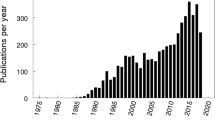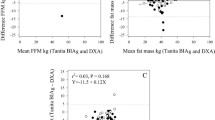Abstract
The assessment of body composition has important applications in the evaluation of nutritional status and estimating potential health risks. Bioelectrical impedance analysis (BIA) is a valid method for the assessment of body composition. BIA is an alternative to more invasive and expensive methods like dual-energy X-ray absorptiometry, computerized tomography, and magnetic resonance imaging. Bioelectrical impedance analysis is an easy-to-use and low-cost method for the estimation of fat-free mass (FFM) in physiological and pathological conditions. The reliability of BIA measurements is influenced by various factors related to the instrument itself, including electrodes, operator, subject, and environment. BIA assumptions beyond its use for body composition are the human body is empirically composed of cylinders, FFM contains virtually all the water and conducting electrolytes in the body, and its hydration is constant. FFM can be predicted by BIA through equations developed using reference methods. Several BIA prediction equations exist for the estimation of FFM, skeletal muscle mass (SMM), or appendicular SMM. The BIA prediction models differ according to the characteristics of the sample in which they have been derived and validated in addition to the parameters included in the multiple regression analysis. In choosing BIA equations, it is important to consider the characteristics of the sample in which it has been developed and validated, since, for example, age- and ethnicity-related differences could sensitively affect BIA estimates.
Similar content being viewed by others
References
Buffa R, Floris GU, Putzu PF et al (2011) Body composition variations in ageing. Coll Antropol 35:259–265
Roubenoff R (2000) Sarcopenia and its implications for the elderly. Eur J Clin Nutr 54:S40–S47
Seidell JC, Hautvast JG, Deurenberg P (1989) Overweight: fat distribution and health risks. Epidemiological observations. A review. Infus Basel Switz 16:276–281
Forsum E, Henriksson P, Löf M (2014) The two-component model for calculating total body fat from body density: an evaluation in healthy women before, during and after pregnancy. Nutrients 6:5888–5899
Meydani M (2001) Nutrition interventions in aging and age-associated disease. Ann N Y Acad Sci 928:226–235
Sjostrom L (1991) A computer based multicompartment body composition technique and anthropometric predictors of lean body mass, total and subcutaneous adipose tissue. Int J Obes 15(S2):19–30
Selberg O, Buchert W, Geaubner G et al (1993) Determination of anatomical skeletal muscle mass by whole body nuclear magnetic resonance. Basic Life Sci 60:95–97
Choi YJ (2010) Dual-energy X-ray absorptiometry: beyond bone mineral density determination. J Nutr Health Aging 14:418–426
Kyle UG, Bosaeus I, de Lorenzo AD et al (2004) Bioelectrical impedance analysis—Part I: review of principles and methods. Clin Nutr Edinb Scotl 23:1226–1243
Böhm A, Heitmann BL (2013) The use of bioelectrical impedance analysis for body composition in epidemiological studies. Eur J Clin Nutr 67:S79–S85
Lukaski HC, Johnson PE, Bolanchuk WW et al (1985) Assessment of fat-free mass using bioelectrical impedance measurement of the human body. Am J Clin Nutr 41:810–817
Segal KR, Van Loan M, Fitzgerald PI et al (1988) Lean body mass estimation by bioelectrical impedance analysis: a four-site cross-validation study. Am J Clin Nutr 47:7–14
Sun SS, Chumlea WC, Heymsfield SB et al (2003) Development of bioelectrical impedance analysis prediction equations for body composition with the use of a multicomponent model for use in epidemiologic surveys. Am J Clin Nutr 77:331–340
Deurenberg P, van der Kooy K, Leenen R et al (1991) Sex and age specific prediction formulas for estimating body composition from bioelectrical impedance: a cross-validation study. Int J Obes 15:17–25
Kyle UG, Genton L, Karsegard L et al (2001) Single prediction equation for bioelectrical impedance analysis in adults aged 20–94 years. Nutrition 17:248–253
Jakicic JM, Wing RR, Lang W (1998) Bioelectrical impedance analysis to assess body composition in obese adult women: the effect of ethnicity. Int J Obes Relat Metab Disord 22:243–249
Roubenoff R, Baumgartner RN, Harris TB et al (1997) Application of bioelectrical impedance analysis to elderly populations. J Gerontol A Biol Sci Med Sci 52:M129–M136
Aleman-Mateo H, Rush E, Esparza-Romero J et al (2016) Prediction of fat-free mass by bioelectrical impedance analysis in older adults from developing countries: a cross-validation study using the deuterium dilution method. Endocrinol Metab (Seoul) 31:25–30
Snyder WS, Cook MJ, Nasset ES et al (1975) Report of the task group on reference men. In: 23rd international commission on radiological protection. Oxford, UK: Pergamon
Baumgartner RN, Koehler KM, Gallagher D et al (1998) Epidemiology of sarcopenia among the elderly in New Mexico. Am J Epidemiol 147:755–763
Gallagher D, Visser M, De Meersman RE et al (1997) Appendicular skeletal muscle mass: effects of age, gender, and ethnicity. J Appl Physiol 83:229–239
Cruz-Jentoft AJ, Baeyens JP, Bauer JM et al (2010) Sarcopenia: European consensus on definition and diagnosis: report of the European Working Group on Sarcopenia in older people. Age Ageing 39:412–423
Janssen I, Heymsfield SB, Baumgartner RN et al (2000) Estimation of skeletal muscle mass by bioelectrical impedance analysis. J Appl Phys 89:465–471
Kyle UG, Genton L, Hans D et al (2003) Validation of a bioelectrical impedance analysis equation to predict appendicular skeletal muscle mass (ASMM). Clin Nutr 22:537–543
Kim JH, Choi SH, Lim S et al (2014) Assessment of appendicular skeletal muscle mass by bioimpedance in older community-dwelling Korean adults. Arch Gerontol Geriatr 58:303–307
Yoshida D, Shimada H, Park H et al (2014) Development of an equation for estimating appendicular skeletal muscle mass in Japanese older adults using bioelectrical impedance analysis. Geriatr Gerontol Int 14:851–857
Sergi G, De Rui M, Veronese N et al (2015) Assessing appendicular skeletal muscle mass with bioelectrical impedance analysis in free-living Caucasian older adults. Clin Nutr 34:667–673
Scafoglieri A, Clarys JP, Bauer JM et al (2016) Predicting appendicular lean and fat mass with bioelectrical impedance analysis in older adults with physical function decline—the PROVIDE study. Clin Nutr. doi:10.1016/j.clnu.2016.04.026
Buckinx F, Reginster JY, Dardenne N et al (2015) Concordance between muscle mass assessed by bioelectrical impedance analysis and by dual energy X-ray absorptiometry: a cross-sectional study. BMC Musculoskelet Disord 18:60
Organ LW, Bradham GB, Gore DT et al (1994) Segmental bioelectrical impedance analysis: theory and application of a new technique. J Appl Physiol 77:98–112
De Rui M, Veronese N, Bolzetta F et al (2016) Validation of bioelectrical impedance analysis for estimating limb lean mass in free-living Caucasian elderly people. Clin Nutr. doi:10.1016/j.clnu.2016.04.011
Nescolarde L, Lukaski H, De Lorenzo A et al (2016) Different displacement of bioimpedance vector due to Ag/AgCl electrode effect. Eur J Clin Nutr. doi:10.1038/ejcn.2016.121
Schell B, Gross R (1987) The reliability of bioelectrical impedance measurements in the assessment of body composition in healthy adults. Nutr Rep Int 36:449–459
Cáceres DI, Sartor-Messagi M, Rodríguez DA et al (2014) Variability in bioelectrical impedance assessment of body composition depending on measurement conditions: influence of fast and rest. Nutr Hosp 30:1359–1365
Deurenberg P, Weststrate JA, Paymans I et al (1998) Factors affecting bioelectrical impedance measurements in humans. Eur J Clin Nutr 42:1017–1022
Gudivaka R, Schoeller D, Kushner RF (1996) Effect of skin temperature on multifrequency bioelectrical impedance analysis. J Appl Physiol 81:838–845
Heyward VH (1998) Practical body composition assessment for children, adults, and older adults. Int J Sport Nutr 8:285–307
Lukaski HC, Bolonchuk WW, Hall CB et al (1986) Validation of tetrapolar bioelectrical impedance method to assess human body composition. J Appl Physiol 60:1327–1332
Caton JR, Mole PA, Adams WC et al (1988) Body composition analysis by bioelectrical impedance: effect on skin temperature. Med Sci Sports Exerc 20:489–491
Garby L, Lammert O, Nielsen E (1990) Negligible effects of physical activity and change in environmental temperature on whole body electrical impedance. Eur J Clin Nutr 44:545–546
Author information
Authors and Affiliations
Corresponding author
Ethics declarations
Conflict of interest
The authors declare that they have no conflict of interest.
Human and animal rights statement
This article does not contain any studies with human participants performed by any of the authors.
Informed consent
For this type of study, informed consent is not required.
Rights and permissions
About this article
Cite this article
Sergi, G., De Rui, M., Stubbs, B. et al. Measurement of lean body mass using bioelectrical impedance analysis: a consideration of the pros and cons. Aging Clin Exp Res 29, 591–597 (2017). https://doi.org/10.1007/s40520-016-0622-6
Received:
Accepted:
Published:
Issue Date:
DOI: https://doi.org/10.1007/s40520-016-0622-6




